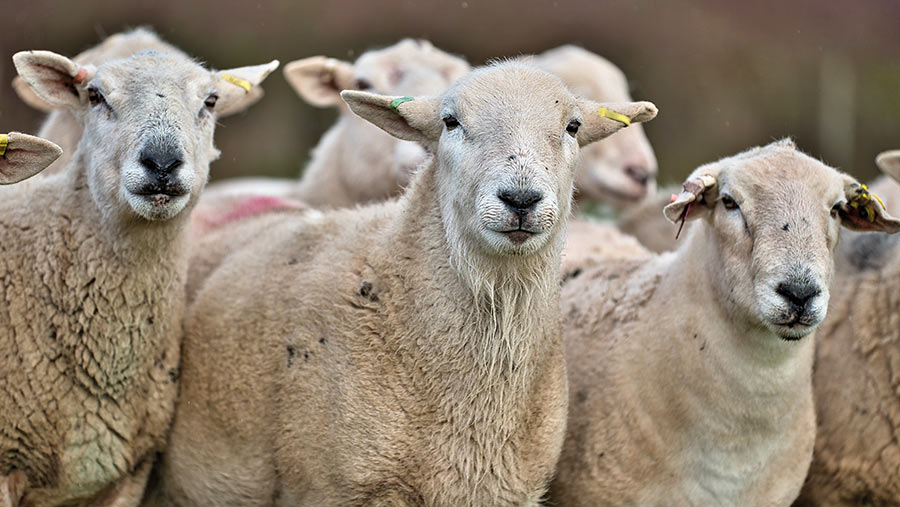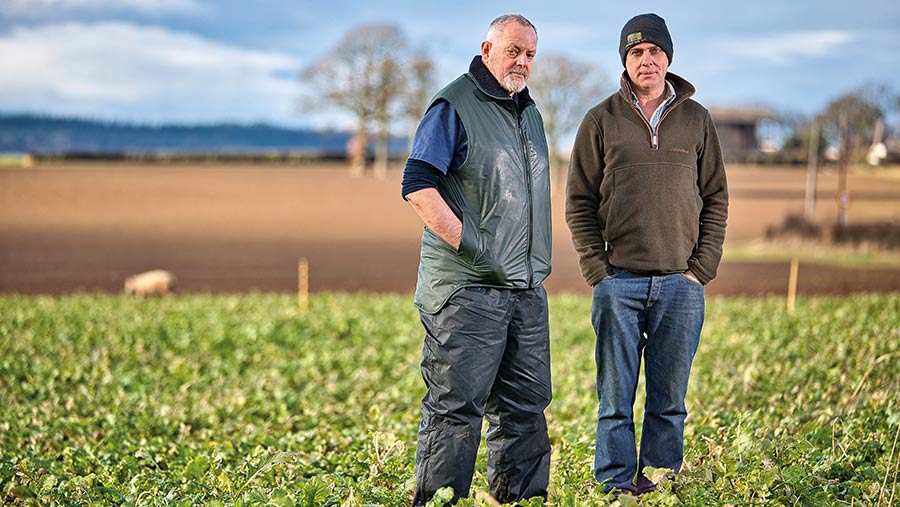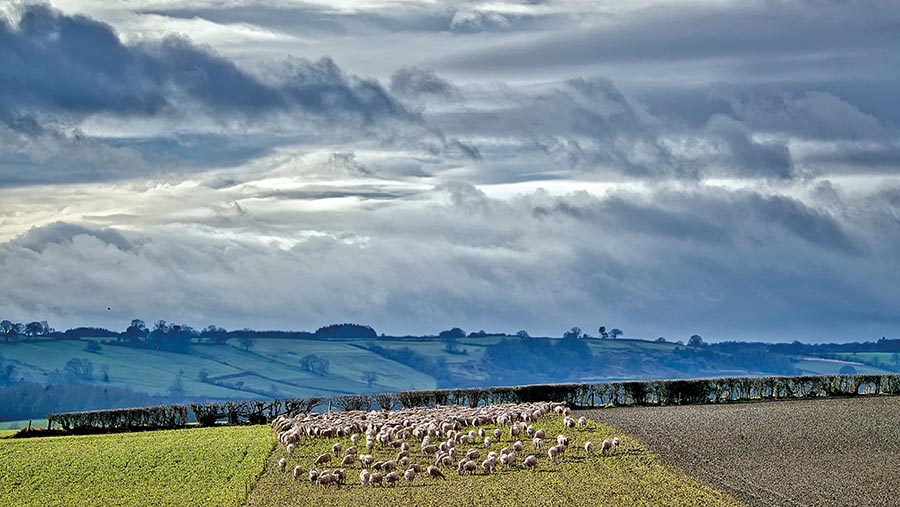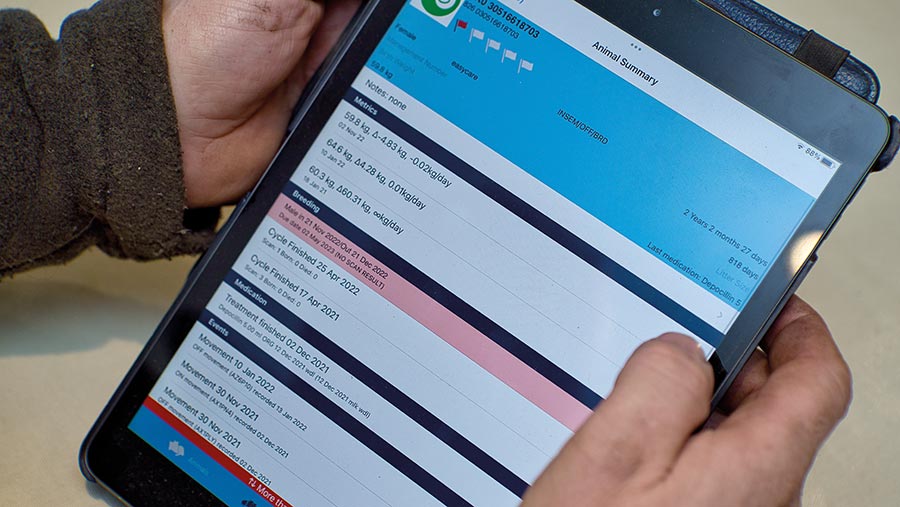Breeders step up hunt for wool-shedding genetics
 Sheep at Hayden Woolley Farm © Richard Stanton
Sheep at Hayden Woolley Farm © Richard Stanton A farmer and a vet are embarking on what they claim is the world’s largest progeny testing scheme of wool-shedding sheep in a quest to breed low-input, low-footprint sheep for UK farmers.
Shropshire sheep and arable farmer Hayden Woolley, and vet Ian McDougall, who provides breeding services for sheep farmers through his company, Farmgene, have imported four wool-shedding breeds.
See also: Sheep breeding index reduces methane and betters performance
They will be putting them to the test in Mr Woolley’s outdoor-lambing flock in a bid to produce performance-recorded stud stock for sale.

Ian McDougall and Hayden Woolley © Richard Stanton
The duo met when Mr Woolley’s flock was selected to provide the bulk of embryos for ram breeder Wairere NZ, and Farmgene was contracted to collect and freeze the embryos.
Farm facts: The Albynes, Bridgnorth, Shropshire
- Farms 4,000 ewes
- Maternal EasyCare and Exlana Rams used since 2015
- Farm area 688ha (1,700 acres) – 182ha (450 acres) owned; the rest rented from six landlords
- 121ha (300 acres) of arable and temporary grass; the rest is permanent pasture
- High-health status flock – all ewes have been health screened and monitored negative for maedi visna, Johne’s and Border disease and no evidence of ovine pulmonary adenocarcinoma has been found
Mr Woolley previously had Romney ewes, but started phasing them out after buying EasyCare ewes from the breed’s pioneer, Iolo Owen, seven years ago.
The motive behind the move was to reduce the workload of crutching and shearing sheep, with the wool not even covering the labour costs associated with shearing.
They agreed that EasyCare genetics had huge potential and could help UK sheep farmers overcome many future challenges by helping to cut production costs.
However, they both believe the current breed needs to extend its gene pool to prevent inbreeding, add hybrid vigour and improve most production traits.
Breeding programme
Altogether, 1,280 ewes were synchronised and either artificially inseminated with semen or implanted with embryos from different sires representing all the major wool-shedding breeds from Australia, New Zealand and Great Britain.
With extensive experience of the sheep industry in the southern hemisphere, Mr McDougall was able to use his expertise to select the best wool-shedding genetics he could find.
Rams from two flocks were selected from the south of Australia because the climate is similar to the UK’s.
“They are bred to thrive in rainfall of 750-900mm and grass grows for nine to 10 months of the year,” he explains.
About 1,130 ewes were artificially inseminated over three weeks and were then split into six groups for repeats to be mated with chaser rams – NZ Wiltshire and high-index UK EasyCare rams.
It is estimated 70% of ewes held to artificial insemination.
A further 600 ewes were single-sire mated to Exlana rams. In addition, 150 embryos (Australian White cross Nudie and pure Australian White) were implanted.
The aim is to create two composite lines:
- A wool-shedding maternal sire
- A wool-shedding terminal sire.
Currently, the ewes are split into two mobs and are on cover crops and roots.
Two weeks before lambing, which is due to start in late March for five weeks, they will be set-stocked on grass fields close to the home farm.
“I want to farm them as commercially as possible and let the good sheep rise to the top,” says Mr Woolley, adding that the sheep will not be given any preferential treatment.
All lambing will be outdoors, followed by rotational grazing on 120ha (300 acres) of parkland split into four 20ha (50-acre) paddocks.
The aim is to raise the size of ewes and make them more prolific without adversely affecting lambing ability.
Terminal breeds such as Australian White and Ultrawhite have been selected to improve lamb quality – specifically growth, carcass quality and weight – because a common criticism of the EasyCare breed is that its lambs are not good enough in these areas.
“Australian lambs are sold at heavier weights [up to 50kg liveweight], so this will provide a good upgrade, but ewes from these flocks still lamb unassisted outside,” says Mr McDougall.

© Richard Stanton
Performance recording
Each lamb will be recorded in the field, with data immediately entered on an iPad using the iLivestock cloud-based programme.
All data will be emailed to Signet and NZ Sheep Improvement Limited (SIL) to generate breeding values.
Instead of being index driven, they will be focused on recording a variety of terminal and maternal traits.
To ensure balance, nothing will be considered in isolation.
Mr McDougall explains the rationale behind his theory: “There is no point in five years’ time having an EasyCare maternal flock that is too lean and has oversized lambs.
“The beauty is that we are not restricted by breed or a brand, so we can ‘let the winners win’,” he adds.
Future
Although they do not intend on adding as many sires next year, Mr McDougall is already searching for rams with a low carbon footprint from New Zealand, and rams resistant to worms from Australia, where huge strides have been made in these fields.
In New Zealand for the past four years, farmers have been able to rent portable methane-recording chambers to help identify sheep that emit low levels of methane.
Mr McDougall and Mr Woolley hope to capitalise on this in the future by carrying out similar tests.
“Scale plays an important part. The more sheep you can choose from – assuming you select wisely – the more that should result in some exceptional animals being bred,” says Mr McDougall.

© Richard Stanton
However, he concedes breeding is a long game: “Short term, you must be prepared to be disappointed.
Breeding is a journey, and you never get to the end, but if you are making progress along the way, that is what matters.”
In three years, he and Mr Woolley hope to have bred a third composite that will breed year-round for use in regenerative arable systems that want to lamb in the autumn and graze cover crops.
“My main motivation for this project is helping others. I started sheep farming with 60 sheep and I made every mistake known to man,” admits Mr Woolley.
“I think we have got the answer, and when subsidies go, sheep farmers will need an answer.”
Breeds used in the progeny test scheme
Australian White
- Poll Dorset, Texel, White Dorper and Van Rooy composite
- Self-replacing sheep
- Predominantly a hair sheep
Ultrawhite
- White Dorper (75%) and Poll Dorset (25%) composite
- Wool-shedding
- Good maternal traits and offers good lamb growth yet low birthweights
Australian Nudie
- Wiltshire cross Dorper with maternal composite rams added
- Bred to survive in high-rainfall areas
- Performance-recorded since 2003 for about 30 different traits
- Leading growth, lameness and fertility traits and parasite resistance
- Wool-shedding
New Zealand Wiltshire
- Polled Wiltshire commercialised in New Zealand since 1950
- Prolific breed – typically records lambing percentages of 180% or more
- Good maternal traits (lambing ease and survival)
- Performance-recorded for more than 20 years
- Hardy, wool-shedding ewe
- Good tolerance to parasites
- Farmgene imported four of these rams from New Zealand, including one ram from Manapari Downs, an organic flock that has not drenched sheep with anthelmintics for 30 years
- Selected three other rams from a flock weaning 185% in an outdoor-lambing system
